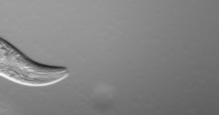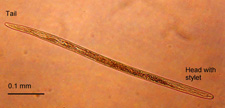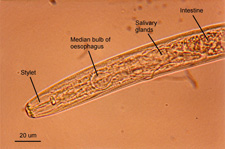 How would you like something worm-like, eight metres long and as thick as a garden hose wriggling (Figure 1) around in your stomach? Well spare a thought for the sperm whale, because that is exactly what it has to put up with! A species of giant nematode (Placentonema gigantissimum) makes its home in the placenta of the sperm whale. That would be enough to make your stomach turn! Humans can also be invaded by nematodes. The good news is that these are much smaller than Placentonema! The bad news is that these invaders can cause serious diseases. The nematode Wuchereria bancrofti for example affects over 100 million people throughout tropical parts of the world. It can grow as long as 10 cm, is spread by mosquito bite, damages the lymphatic system and causes large, debilitating swellings in different parts of the body referred to as ‘elephantiasis’. Other nematode parasites of humans are transmitted by eating meat that is not cooked sufficiently or through contact with faeces, or water contaminated with faeces, from humans or animals. So wash your hands and watch what you eat and drink! Some species of nematodes live in the stomach of animals and prevent them from absorbing sufficient nutrients to grow properly. Farmers commonly treat their livestock with chemicals called ‘drenches’ or ‘anthelmintics’ to kill such nematode infestations. Similarly, pet owners often treat their pets with ‘worm’ tablets.
How would you like something worm-like, eight metres long and as thick as a garden hose wriggling (Figure 1) around in your stomach? Well spare a thought for the sperm whale, because that is exactly what it has to put up with! A species of giant nematode (Placentonema gigantissimum) makes its home in the placenta of the sperm whale. That would be enough to make your stomach turn! Humans can also be invaded by nematodes. The good news is that these are much smaller than Placentonema! The bad news is that these invaders can cause serious diseases. The nematode Wuchereria bancrofti for example affects over 100 million people throughout tropical parts of the world. It can grow as long as 10 cm, is spread by mosquito bite, damages the lymphatic system and causes large, debilitating swellings in different parts of the body referred to as ‘elephantiasis’. Other nematode parasites of humans are transmitted by eating meat that is not cooked sufficiently or through contact with faeces, or water contaminated with faeces, from humans or animals. So wash your hands and watch what you eat and drink! Some species of nematodes live in the stomach of animals and prevent them from absorbing sufficient nutrients to grow properly. Farmers commonly treat their livestock with chemicals called ‘drenches’ or ‘anthelmintics’ to kill such nematode infestations. Similarly, pet owners often treat their pets with ‘worm’ tablets.
 |
Figure 1. Caenorhabditis elegans is not as big as the giant sperm whale nematode, but is a nematode of enormous importance to science. The article provides a brief overview of nematodes in general, and explains the importance of plant parasitic nematodes. What do you think, is this nematode a plant parasite? How can you tell? (read the article, the answer is at the very bottom)
Movie from Goldstein lab. Click on the movie for a larger version from http://www.bio.unc.edu/faculty/goldstein/lab/movies.html, used with permission. Copyright information for: the small version and for the larger version |
Some nematodes feed on plants and are commonly referred to as ‘eelworms’ in the British-speaking world. Most plant nematodes are less than 1 mm long and almost invisible to the eye. They may not impress you the way the sperm whale nematode would, but they are responsible for some 15% loss to crops per annum world-wide, equating to some US$78 billion! Plant feeding nematodes have a sharp needle-like structure in their mouth called a ‘stylet’ (Fig 2A, 2B). The stylet acts like a very small hypodermic needle and is used to pierce through cell walls and suck out the cell contents. An example of the losses caused by eelworms is the pine wilt nematode (Bursaphelenchus xylophilus) which has been associated with the death of tens of millions of pine trees in Japan. How can something less than 1 mm long cause such devastation? The answer lies in reproduction, with the nematode reaching populations of billions per tree. That’s a lot of hungry mouths!
 |
 |
| Figure 2a (click to enlarge) |
Figure 2b (click to enlarge) |
Most plant feeding nematodes live in the soil and feed on plant roots, thereby reducing the plant’s uptake of water and nutrients, and reducing tolerance to other stresses such as drought. Some transmit other disease causing agents (e.g. viruses) to plants as they feed. When numbers of eelworms get too high in the soil, farmers sometimes apply chemicals called fumigants or nematicides to the soil to control them. However, these chemicals are generally very toxic and hazardous to the health of both humans and the environment. Some nematicides have been banned because they were found to easily leach through the soil and contaminate drinking water in aquifers.
Fortunately, most species of nematodes have no effect, or have a beneficial effect, on humans and their endeavours. Many species of nematodes are ‘free-living’, living in soil, sea and freshwater. These feed on bacteria, fungi, protozoans and even other nematodes, and play a very important role in nutrient cycling and release of nutrients for plant growth. Other nematodes attack insects, and help to control insect pests. In fact, some nematodes which attack insect pests are reared commercially and released for the control of certain insect pests as a biological insecticide. A nematode released to control the Sirex wood wasp has been credited with saving the forestry industry up to 80 million US dollars per year in Australia.
Nematodes are also important in other ways. The nematode Caenorhabditis elegans was the first multi-cellular organism to have its DNA fully sequenced. This has led to many exciting breakthroughs in the biological and medical sciences in the last few years. This nematode is also famous in that some individuals, being carried onboard as part of an experiment, survived the Space Shuttle Columbia disaster in 2003!
Nematodes can be found from the depths of the ocean to mountain tops. A spadeful of soil can contain more than a million nematodes! Because nematodes are so numerous and occur in so many habitats, it has been suggested that if we removed everything from our planet but nematodes, much of the topography of the Earth would still be recognisable as a film of nematodes!
So while nematodes are generally small and often unnoticeable, they have an enormous impact on us and our world. Watch out for them!
Further Resources:
For further general information on nematodes follow this link: http://www.apsnet.org/edcenter/K-12/TeachersGuide/Nematode/Pages/MaterialsandMethods.aspx
For further information on plant-parasitic nematodes follow this link: http://www.apsnet.org/edcenter/intropp/PathogenGroups/Pages/IntroNematodes.aspx
Further information on the sequencing of the genome of Caenorhabditis elegans can be found at:
http://www.apsnet.org/publications/apsnetfeatures/Pages/Celegans.aspx
Answer to question about Figure 1: Caenorhabditis elegans is not a plant parasitic nematode; it does NOT have a stylet like the one seen in Figure 2
